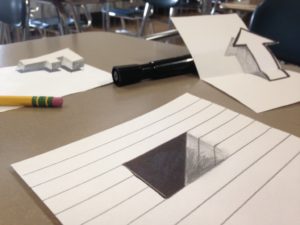Recently, I’ve had a lot of people ask me “Hey, I just started teaching STEM/STEAM to all of the K-6 students at our school…they’re with me 40 minutes and I see them once a week…how do I start?”
I get it.
So many schools notice that other schools around are adding STEM and STEAM classes and decide to add them too. Which is awesome! I love seeing STEM and STEAM join the rotation with Gym, Music, and Art classes in elementary schools.
But I think the conversation on starting a STEM class probably sounds a little like this:
“Hey, School X in the next town has a STEM class. We should have one.”
“I agree. Who should we have teach it?”
“Teacher Y is pretty good at using those Chromebooks we handed out last year.”
“Right, and they wrote a grant to get a 3d Printer for their classroom.”
“Perfect, let’s go tell them they’ll be teaching 800 K-5th graders next year.”
So of course you said “Yes! I’d absolutely love to teach STEM/STEAM!”
And now you’ve been teaching for one week or one month or one year. And you’ve run out of ideas.
And the questions & concerns are starting to pile up higher than the stack of books you wanted to read last summer.
Don’t worry. You’re doing a wonderful thing. Something so wonderful it’ll have a lifetime impact on your kids!
So, here’s some ideas to help and important lessons to remember in your first (or 15th) year of being a STEM or STEAM teacher:
1. STEM and STEAM are more than just kits and programs and books. STEM is around us every day. When you’re reading the news (in a newspaper, magazine, or online) look for the “Technology” or “Science” section to see what new innovations are on the horizon. Then find a way to adapt that to a classroom activity.
For example, this story on Bloomberg news is about the Future of Farming with Artificial Intelligence and Machinery. That’s an obvious starting point for a classroom activity growing things with hydroponics or using temperature sensors or just planting seeds. Plus it shows kids the amazing future of jobs!
2. You WILL get sick and need to call for a substitute  teacher. They will be surprised by the noise and seemingly chaotic culture you have created with your kids. Don’t worry. Teach your students this line to repeat to any substitute that shows up: “Noise means we’re collaborating. Messes mean we’re trying.” Come to think of it, maybe that should be a poster on your wall. Have some kids design one tomorrow.
teacher. They will be surprised by the noise and seemingly chaotic culture you have created with your kids. Don’t worry. Teach your students this line to repeat to any substitute that shows up: “Noise means we’re collaborating. Messes mean we’re trying.” Come to think of it, maybe that should be a poster on your wall. Have some kids design one tomorrow.
3. Remember that STEM and STEAM can impact your school and community. Don’t confine your students to your classroom. Get them outside, in the hallways, playground, and neighborhoods, doing things that can help others out.
Offer up your students to create and make posters for other teachers. Let them design doorstops and 3d print them. Or take them around your school or town to pick up garbage. Did you know you can even use an app called Litterati to take pictures of the garbage with geolocation data and analyze the data? Or bring back some of the “best garbage” to turn into art or repurpose into something useful.
4. Keep a clipboard or list on your phone of ideas you come across that you could do in your classroom. My phone is filled (and when I say filled, I mean “have to delete an app so I can take a picture of this cool STEM idea” filled) with ideas to use in my class. Because there’s nothing worse than seeing a great idea, not writing it down, and getting frustrated because you can’t remember it.
5. Encourage kids to do STEM with their parents at home.  An hour or less of STEM or STEAM per week is never enough. Kids used to build and create and make and invent in their backyard, basement, and garage all the time. Besides, what kids you know already spend too much time with their parents? Check out this previous post for 77 ideas that kids and parents can do together (or maybe they’re ideas you can do in your classroom too!)
An hour or less of STEM or STEAM per week is never enough. Kids used to build and create and make and invent in their backyard, basement, and garage all the time. Besides, what kids you know already spend too much time with their parents? Check out this previous post for 77 ideas that kids and parents can do together (or maybe they’re ideas you can do in your classroom too!)
6. When you run out of ideas, ask for more. Twitter is filled with super educators (many of them STEM and STEAM teachers) sharing the great things their students are doing. And they’re more than happy to let you steal their ideas (because many of them stole them from someone else). Search hashtags like #STEM or #STEAM, and don’t spend too long looking. It can get overwhelming. Just get a few ideas and let them roll around in your head.
Here’s just a few STEM and STEAM educators I know that you can follow for great ideas:
Jason Hubbard https://twitter.com/jsnhubbard
Brittany Ballou https://twitter.com/ImagineerSTEAM
Nancy Penchev https://twitter.com/Penchevable
Amy Farkas https://twitter.com/FarkasSTEM
John VanDusen https://twitter.com/Mr_JVD
Andrew Kauffman https://twitter.com/atkauffman/
…and of course I’d suggest my Twitter https://twitter.com/dailystem and my STEM Everyday Podcast for more ideas
7. And lastly, don’t forget your kids have ideas too! Encourage your kids to bring in ideas or items from home that need fixing or improving. If you can get your kids to “see STEM” in the world around them, you’re doing it right.

Well, hopefully that helps. And keep in mind, I’m always willing to come to your school or conference and share many more practical ideas. I can help your whole staff have a new appreciation for STEM and STEAM as more than just a buzzword or acronym.
It’s important that kids know STEM is way more than just a class to go to once a week. For STEM and STEAM to really make a difference in a child’s life, it needs to be part of every classroom, every day.
